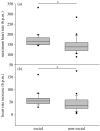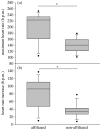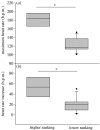Heart rate modulation in bystanding geese watching social and non-social events
- PMID: 18430645
- PMCID: PMC2602813
- DOI: 10.1098/rspb.2008.0146
Heart rate modulation in bystanding geese watching social and non-social events
Abstract
Simply observing other individuals interacting has been shown to affect subsequent behaviour and also hormones in 'bystander' individuals. However, immediate physiological responses of an observer have been hardly investigated. Here we present results on individuals' heart rate (HR) responses during various situations, which occur regularly in a flock of greylag geese (Anser anser, e.g. agonistic encounters, vehicles passing by). We recorded simultaneously HR and behaviour of 21 semi-tame free-roaming geese, equipped with fully implanted transmitters. We considered 304 social and 81 non-social events during which the focal individuals did not respond behaviourally. Independent of the spatial distance to the event, these HR responses were significantly greater in social contexts (e.g. departing or landing geese, agonistic interactions) than in non-social situations (e.g. vehicles passing by, thunder). Focal individuals showed a significantly higher maximum HR as well as a greater HR increase in response to agonistic interactions, in which the pair partner or a family member was involved, as compared with a non-affiliated goose. Also, HR was significantly higher when the bystander watched non-affiliated geese interacting, which were higher ranking than the focal. We conclude that these differences are due to different relevance of the recorded events for the focal individual, depending on the individuals involved in the observed interaction.
Figures




References
-
- Arnold W, Ruf T, Reimoser S, Tataruch F, Onderscheka K, Schober F. Nocturnal hypometabolism as an overwintering strategy of red deer (Cervus elaphus) Am. J. Physiol. 2004;286:174–181. doi:10.1152/ajpregu.00593.2002 - DOI - PubMed
-
- Aureli F. Post-conflict anxiety in nonhuman primates: the mediating role of emotion in conflict resolution. Aggress. Behav. 1997;23:315–328. doi:10.1002/(SICI)1098-2337(1997)23:5<315::AID-AB2>3.0.CO;2-H - DOI
-
- Aureli F, Cozzolino R, Cordischi C, Scucchi S. Kin-oriented redirection among Japanese macaques: an expression of a revenge system? Anim. Behav. 1992;44:283–291. doi:10.1016/0003-3472(92)90034-7 - DOI
-
- Aureli F, Preston S.D, de Waal F.B.M. Heart rate responses to social interactions in free-moving rhesus macaques (Macaca mulatta): a pilot study. J. Comp. Psychol. 1999;113:59–65. doi:10.1037/0735-7036.113.1.59 - DOI - PubMed
-
- Bastian H.-V. Die Änderung der Herzfrequenz als Maß der Erregung- eine Literaturübersicht. Die Vogelwarte. 1984;32:226–233.
Publication types
MeSH terms
LinkOut - more resources
Full Text Sources

